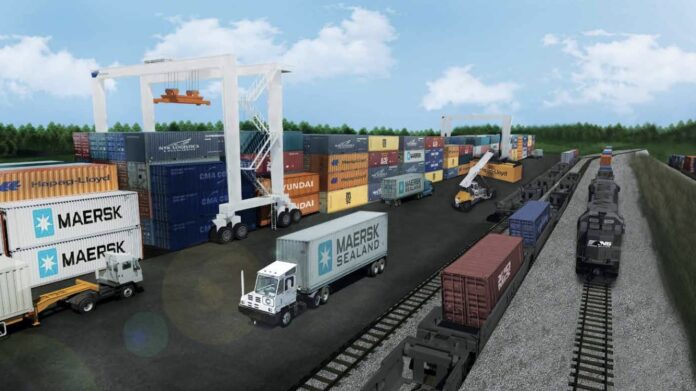
There’s been a lot of talk about how the $170 million Northeast Georgia Inland Port will impact North Georgia. But its potential effect on Habersham County still remains to be seen.
By 2026, a 104-acre tract at Gateway Industrial Centre off GA 365 and White Sulphur Road will become the bustling Inland Port terminal – also known as the Blue Ridge Connector – where semi trucks will load and unload cargo on and off a 3,000-foot train running to and from Savannah’s harbor via a 324-mile freight service rail line.
While it’s intended to reduce the amount of semi truck traffic statewide, the port is expected to have a sizable impact on roads in North Georgia, with a concentration of 18-wheelers in North Hall traveling to and from the site, as well as population growth from new development, a likely outcome.
At first, once the facility is complete, the area around the inland port could see up to 160 additional semi trucks a day. By “full buildout” in 2050, according to the Georgia Ports Authority, an estimated 400 semi trucks (one truck every two minutes) could be loading or unloading goods at the port daily. But officials with the Georgia Mountains Regional Commission said that number will be far greater.
Specifically, 800 trucks a day (400 loading and another 400 unloading).
Still, despite the projected increased volume of truck traffic at a port located about 15 miles from Habersham’s border, GDOT officials haven’t identified a need for road improvements that far north.
“I wouldn’t say there’s any Habersham County projects specifically related to the inland port,” said Justin Lott, a pre-construction engineer with GDOT. “Most of the projects, like widening, are to plan for volume in the future.”
According to Lott, it’s still unclear as to how much additional traffic could be coming through Habersham once the Northeast Georgia Inland Port is operational.
Industrial development, as well as population growth, is expected to flock to Habersham and other parts of Northeast Georgia with the port’s arrival.
To Habersham’s southwest, Hall County Administrator Zach Propes has said an estimated 9,682 new jobs “supported by port activity” already have been added in recent years.
“I don’t know any specific route,” Lott said. “I imagine most of them would be on (GA) 365 and (U.S.) 441. I have heard from some other cities that have some concerns with increases in truck traffic from the port. I don’t see it as a huge net increase because, in theory, trucks in Savannah are getting that load and delivering it here in Northeast Georgia…the trucks would likely be going to similar locations. I don’t see it as a huge increase, but there may be some.”
Lott said GDOT will continue to work closely with officials to identify potential road improvements and continue to reassess needs in the future.
“Of course, needs are constantly changing based on where (new) developments are and growth in the area,” he said. “…if development starts coming in, we’ll start looking at that area too.”
County officials respond
Habersham County Commission Vice Chairman Bruce Harkness said that while he opposes new development along the GA 365 corridor, he plans to ensure county and GDOT officials continue to address infrastructure needs in South Habersham.
“We have a dilemma,” Harkness said. “Growth is knocking, literally, at our door at the Hall County line. The reason why we don’t have so much uncontrolled growth at the southern end of the county is we don’t have water/sewer…vast, vast majorities of people who voted for me told me they want me to try to stop and restrict growth at all costs. That’s what the voters asked me to do. We have a small slice of heaven (in Habersham) and if we don’t protect it, it will be gone forever.”
“We don’t have the infrastructure for 30,000-40,000 people to come here, much less 100,000,” Harkness added. “Certainly, we do need to work with GDOT more.”
Commissioner Ty Akins said he also believes county officials should talk closer with GDOT officials in the years ahead.
“I hope to see additional dialogue with GDOT in the coming years to account for growth from the inland port,” Akins said.







